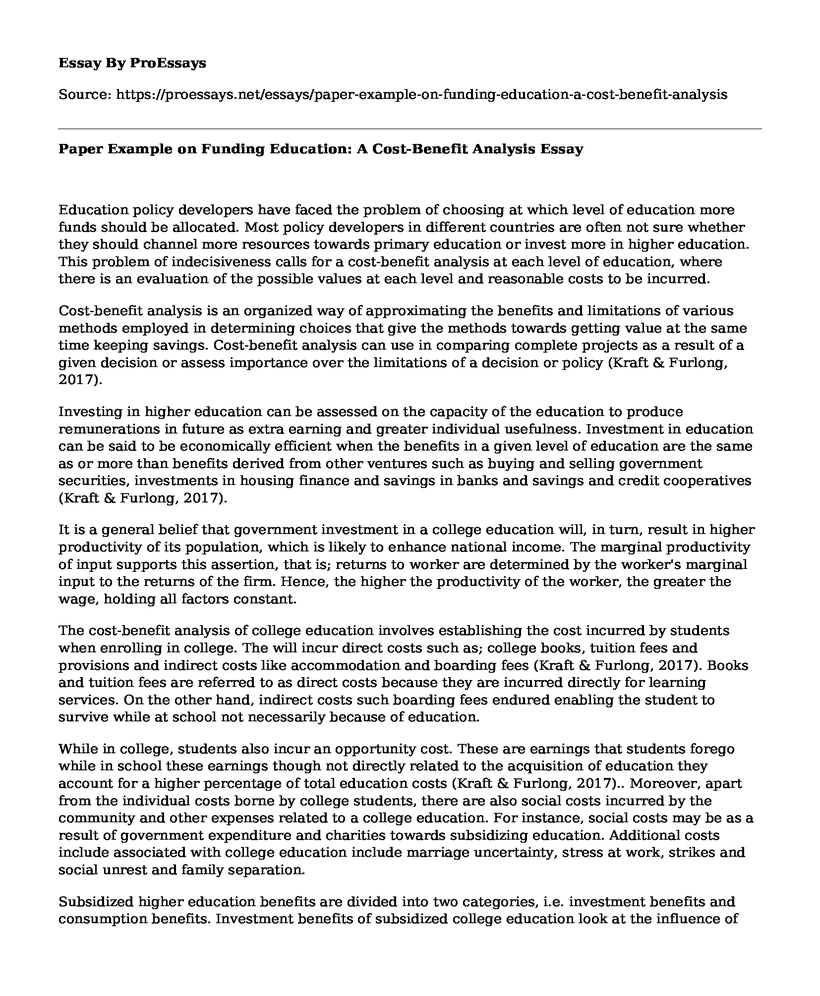Education policy developers have faced the problem of choosing at which level of education more funds should be allocated. Most policy developers in different countries are often not sure whether they should channel more resources towards primary education or invest more in higher education. This problem of indecisiveness calls for a cost-benefit analysis at each level of education, where there is an evaluation of the possible values at each level and reasonable costs to be incurred.
Cost-benefit analysis is an organized way of approximating the benefits and limitations of various methods employed in determining choices that give the methods towards getting value at the same time keeping savings. Cost-benefit analysis can use in comparing complete projects as a result of a given decision or assess importance over the limitations of a decision or policy (Kraft & Furlong, 2017).
Investing in higher education can be assessed on the capacity of the education to produce remunerations in future as extra earning and greater individual usefulness. Investment in education can be said to be economically efficient when the benefits in a given level of education are the same as or more than benefits derived from other ventures such as buying and selling government securities, investments in housing finance and savings in banks and savings and credit cooperatives (Kraft & Furlong, 2017).
It is a general belief that government investment in a college education will, in turn, result in higher productivity of its population, which is likely to enhance national income. The marginal productivity of input supports this assertion, that is; returns to worker are determined by the worker's marginal input to the returns of the firm. Hence, the higher the productivity of the worker, the greater the wage, holding all factors constant.
The cost-benefit analysis of college education involves establishing the cost incurred by students when enrolling in college. The will incur direct costs such as; college books, tuition fees and provisions and indirect costs like accommodation and boarding fees (Kraft & Furlong, 2017). Books and tuition fees are referred to as direct costs because they are incurred directly for learning services. On the other hand, indirect costs such boarding fees endured enabling the student to survive while at school not necessarily because of education.
While in college, students also incur an opportunity cost. These are earnings that students forego while in school these earnings though not directly related to the acquisition of education they account for a higher percentage of total education costs (Kraft & Furlong, 2017).. Moreover, apart from the individual costs borne by college students, there are also social costs incurred by the community and other expenses related to a college education. For instance, social costs may be as a result of government expenditure and charities towards subsidizing education. Additional costs include associated with college education include marriage uncertainty, stress at work, strikes and social unrest and family separation.
Subsidized higher education benefits are divided into two categories, i.e. investment benefits and consumption benefits. Investment benefits of subsidized college education look at the influence of higher education on the income of an individual in future. Investment benefits more specific calculates income differences between students who graduate from college and those who graduate from high school at a particular stage as a result of higher education. On the other hand, consumption benefits focus on the usefulness of knowledge, for example, the ability to appreciate art and literature and use leisure time efficiently.
There are two methods used in the evaluation of benefits and costs to be incurred when establishing a course action. These methods include; the internal level of interest and current disposable value. The current disposable cost of higher education is to used calculate the change between the current rate of earnings attributed to a graduate from an institution of higher learning and the present value of profits associated to a graduate from secondary school with same attributes (Kraft & Furlong, 2017). Internal level of benefit uses income as the base to calculate the level of benefit of education. It is the preferred way of computation than the disposable current cost method. Many researchers prefer the intimate scale of benefit as it doesn't require a predetermined discount level.
Conclusion
Education policymaking, should not be limited to deliberations of influential usefulness only, but also should be able to deal with problems associated with excellent stability and relevant education. Such issues may not be conclusively dealt with cost-benefit analysis . A cost-benefit analysis should be taken as an insufficient in education policy formulation. Hence policy formulation requires additional formulation tools apart from a cost-benefit analysis. Since cost-benefit analysis alone cannot adequately cover the issues of rights of parties, moral stability and education relevance.
Reference
Kraft, M. E., & Furlong, S. R. (2017). Public policy: Politics, analysis, and alternatives (6th ed.).
Cite this page
Paper Example on Funding Education: A Cost-Benefit Analysis. (2023, May 08). Retrieved from https://proessays.net/essays/paper-example-on-funding-education-a-cost-benefit-analysis
If you are the original author of this essay and no longer wish to have it published on the ProEssays website, please click below to request its removal:
- Personal Essay Example: My Opportunity in Visiting Tokyo
- Case Studies on Financial Management
- The Journey That Changed My Life Essay
- The Difference Between Truth and Opinion Paper Example
- Essay Sample on Relationship in Loss of Motivation and New Environment
- Essay Sample on Trigger Warnings: Pressure on Students in Education Centers
- Navigating Boomerang and Failure-to-Launch: Challenges Faced by Young Adults Returning Home







